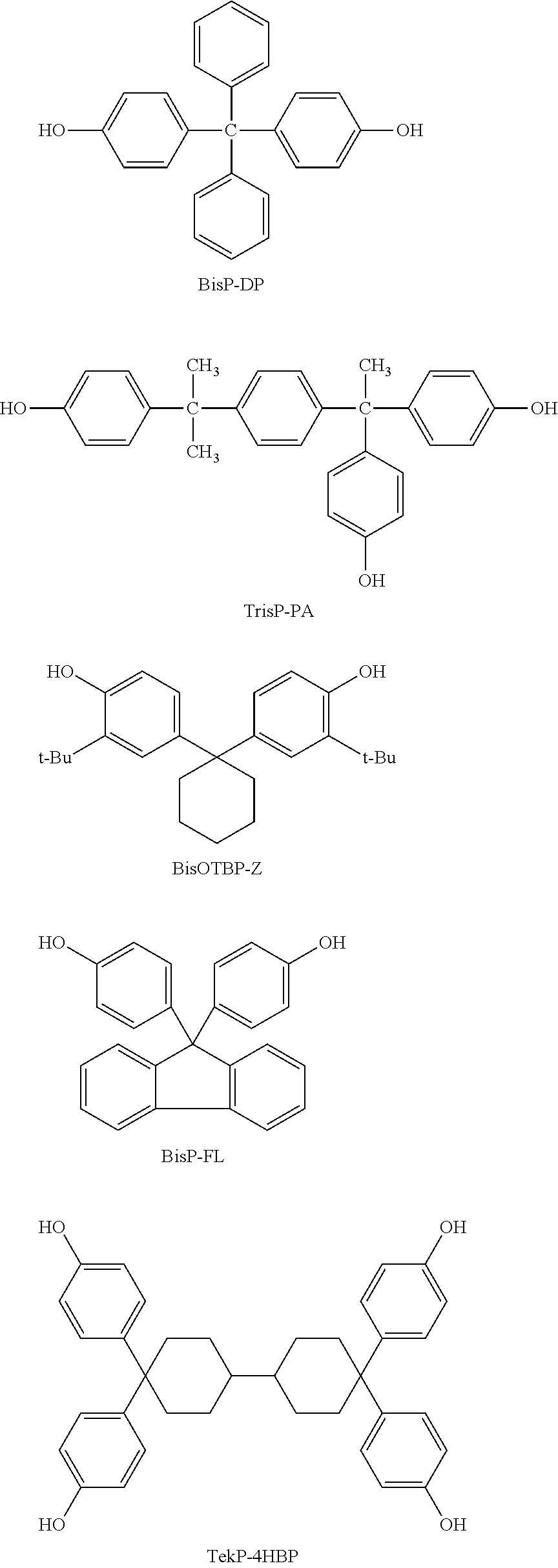Photosensitive siloxane resin composition
a technology of siloxane resin and composition, applied in the field of photosensitive composition, can solve the problems of reducing sensitivity, prone to pattern collapse, and deterioration of resin, and achieve excellent temporal stability and sensitivity, improve alkali-solubility, and high transparency
- Summary
- Abstract
- Description
- Claims
- Application Information
AI Technical Summary
Benefits of technology
Problems solved by technology
Method used
Image
Examples
production example 1
Production of Siloxane Resin Solution X
[0098]In 200 g of 3-methyl-3-methoxybutanol, 47.6 g (0.35 mol) of methyltrimethoxysilane, 29.7 g (0.15 mol) of phenyltrimethoxysilane and 4.83 g (0.015 mol) of 3,3′,4,4′-benzophenonetetracarboxylic dianhydride were dissolved. While the solution was stirred at 30° C., 34.2 g of distilled water was added therein. The solution was then kept stirred and heated for 1 hour to conduct hydrolysis-condensation. Subsequently, the solution was washed five times with water, and the ethyl acetate oil layer was collected. The ethyl acetate oil layer was concentrated and then the ethyl acetate was replaced with PGMEA, to obtain a 40% solution of methyl-phenyl silsesquioxane condensation polymer.
[0099]The obtained siloxane resin was a methyl-phenyl silsesquioxane (methyl:phenyl=7:3 by molar ratio) having a weight average molecular weight (Mw) of 1250.
production example 2
Production of Siloxane Resin Solution Y
[0100]In 200 g of 3-methyl-3-methoxybutanol, 47.6 g (0.35 mol) of methyltrimethoxysilane, 29.7 g (0.15 mol) of phenyltrimethoxysilane and 4.83 g (0.015 mol) of 3,3′,4,4′-benzophenonetetracarboxylic dianhydride were dissolved. While the solution was stirred at 40° C., 34.2 g of distilled water was added therein. The solution was then kept stirred and heated for 1 hour to conduct hydrolysis-condensation. Subsequently, the solution was washed five times with water, and the ethyl acetate oil layer was collected. The ethyl acetate oil layer was concentrated and then the ethyl acetate was replaced with PGMEA, to obtain a 40% solution of methyl-phenyl silsesquioxane condensation polymer.
[0101]The obtained siloxane resin was a methyl-phenyl silsesquioxane (methyl:phenyl=7:3 by molar ratio) having a weight average molecular weight (Mw) of 1500.
[0102]Here, the weight average molecular weight (Mw) was determined according to gel-permission chromato-graphi...
example 1
[0103]To 67.63 g of the siloxane resin solution X produced in Production example 1, 0.14 g of a surfactant KF-54 ([trademark], manufactured by Shin-Etsu Chemical Co., Ltd.), 0.14 g of a naphthoquinone photo-sensitive material P represented by the following formula:
[0104]
and 29.43 g of PGMEA as a solvent were added and dissolved with stirring to obtain a 30% solution. The obtained solution was filtrated through a 47 mmφ filter (filtration accuracy: 0.1 μm; PTFE [trademark], manufactured by Advantec Toyo Kaisha Ltd.) under a pressure increased by 0.05 MPa, and then collected in a clean polyethylene container (AC100-H [trademark], manufactured by AICELLO CHEMICAL CO., Ltd.) to prepare a photosensitive siloxane composition.
PUM
| Property | Measurement | Unit |
|---|---|---|
| wave-length range | aaaaa | aaaaa |
| temperature | aaaaa | aaaaa |
| temperature | aaaaa | aaaaa |
Abstract
Description
Claims
Application Information
 Login to View More
Login to View More - R&D
- Intellectual Property
- Life Sciences
- Materials
- Tech Scout
- Unparalleled Data Quality
- Higher Quality Content
- 60% Fewer Hallucinations
Browse by: Latest US Patents, China's latest patents, Technical Efficacy Thesaurus, Application Domain, Technology Topic, Popular Technical Reports.
© 2025 PatSnap. All rights reserved.Legal|Privacy policy|Modern Slavery Act Transparency Statement|Sitemap|About US| Contact US: help@patsnap.com



